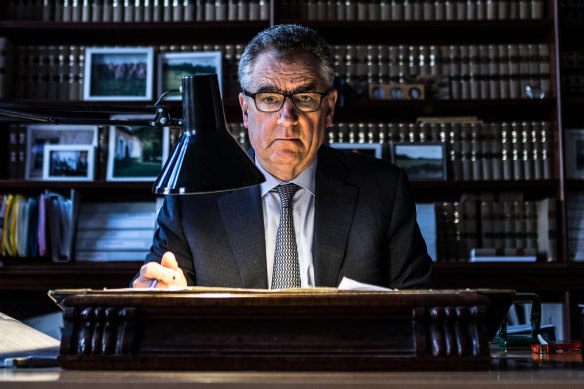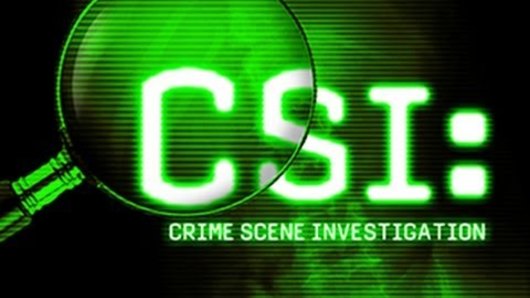By Liam Mannix
A senior judge believes innocent people may have been jailed because too much faith has been placed in forensic techniques that have been proved to be flawed.
Justice Chris Maxwell, President of the Victorian Court of Appeal, said there was little proof that forensic techniques including gunshot analysis, footprint analysis, hair comparison and bite mark comparison could reliably identify criminals.
He called on governments around Australia to urgently change the law, so that judges had to consider the reliability of forensic evidence before it was shown to juries.

Justice Chris Maxwell, President of the Court of Appeal.Credit: Jason South
Two major American reports have concluded that DNA analysis is the only forensic technique that is absolutely reliable.
"There have been a string of wrongful convictions across the world," Justice Maxwell said. " The benefit of better DNA testing has shown that very many people convicted on the basis of 'crook science', for example, bite mark analysis, were innocent.
“This seems to me to be a matter of profound concern.”
The judge's comments come after The Age revealed last month grave concerns that the legal system and forensic scientists were ignoring systemic problems with forensic evidence.
Daniel Gurvich, QC, chair of the Criminal Bar Association of Victoria, said the Victorian government should now establish an inquiry into the accuracy of forensic science, calling it "a matter of great concern in the administration of justice".
"We do agree with the president’s fears that unreliable forensic evidence is being admitted into evidence in trials," he said.
“We think unreliable forensic evidence should not get to the jury in the first place. And the danger of juries being misled, or deferring to an expert opinion, is significant.
“We consider that urgent legislative change is required.”
The two critical American reports, published in 2009 and 2016, led to major changes to the US and British legal systems. Not so in Australia.
“When I learnt about those reports ... I was shocked," Justice Maxwell said.
“With the exception of DNA, no other area of forensic science has been shown to be able reliably to connect a particular sample with a particular crime scene or perpetrator.
“I was asking myself, ‘Why are we not having appeals based on questions of admissibility of forensic evidence?’

Justice Maxwell said the rise of television shows such as CSI had given juries the idea that forensic evidence was perfect. Credit:
“If, as these US reports show, almost none of it is properly validated, then there must be widespread questions of reliability of the science being relied on.
"This seems to me to be so important to the integrity of the criminal justice system. I would have thought it was essential for us to take stock of the state of forensic science in Australia.”
A 2016 High Court ruling has meant judges cannot stop evidence from being shown to the jury over concerns of reliability.
Justice Maxwell said the rise of shows such as CSI and NCIS had given juries the idea that forensic evidence was perfect and criminals could be identified with 100 per cent accuracy.
That meant when CSI-style evidence was presented, jurors were more likely to believe it – even if the science behind it was flawed.
“[It is a] powerful form of evidence, which can easily be overvalued because it appears to prove more than it can reliably prove," Justice Maxwell said.
The Uniform Evidence Act 1995 needed to be urgently amended to require judges to consider the reliability of expert evidence before allowing it to be presented to the jury, he said.
In 1995, David Eastman was convicted by a jury of the murder of Colin Winchester. A key plank of the circumstantial case against Mr Eastman was forensic evidence that gunshot residue found in his car matched that found at the crime scene.
A 2014 inquiry into the case concluded the forensic evidence “lacked a proper scientific foundation”, and recommended Mr Eastman’s conviction be quashed. By that time he had spent 19 years in jail.
In 1985, three forensic dentists testified at the trial of Raymond Carroll, all claiming a bite mark found on the leg of a murdered infant matched Mr Carroll's teeth. He was convicted.
Bite mark evidence has now been thoroughly discredited, with tests showing forensic dentists are often unable to tell if a bite mark was even caused by a human – let alone identify a suspect. Mr Carroll's conviction was later quashed.
A spokesman for the Victorian Attorney-General said laws and processes were in place to govern the reliability of forensic science in the state's courts.
"The Victorian government will continue to monitor the effectiveness of the existing measures and review any opportunities for improvement," the spokesman said.
Dr Linzi Wilson-Wilde, director of the National Institute of Forensic Science, rejected Justice Maxwell's criticisms.
"The United States PCAST report [the critical 2016 report from the President's Council of Advisers on Science and Technology] is three years old and considerable work has been, and continues to be, undertaken to address findings contained in the report.
"The US PCAST findings have been raised in criminal trials in Australia and no issues were identified.
"The evidence provided by government forensic services providers is robust and accounts for limitations in the assessment and interpretation they perform, and in the reports they prepare."